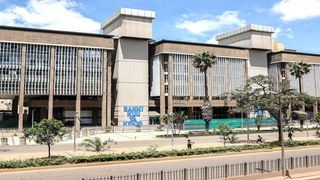
The Central Bank of Kenya in Nairobi County on January 28, 2024.
| File | Nation Media GroupBusiness
Premium
After tax pain, here come expensive bank loans
Commercial banks are now charging more than 26 percent interest on loans in another round of credit repricing that signals more pain for risky borrowers amid a surge in defaults.
Tier I lender Equity Bank has, for instance, set 26.74 percent as the lending rate for new loans to high-risk borrowers from a previous peak of 26.06 percent.
The adjustments in the cost of credit have been primarily driven by the expansion of tighter lending conditions, with the Central Bank of Kenya (CBK) having increased the benchmark lending rate back-to-back in the past two months.
The CBK lifted the key lending rate to 13 percent this month after adjusting it from 10.5 percent to 12.5 percent at its policy meeting in December.
Commercial banks have subsequently translated the tighter lending rates to borrowers with corresponding adjustments to loan prices.
“Following the adjustment of the Central Bank Rate (CBR) from 10.5 to 12.5 percent in December 2023 and from 12.5 percent to 13 percent in February 2024, Equity Bank wishes to notify our customers and the general public, that the bank shall, effective February 20, 2024, adjust Equity Bank’s Reference rate (EBRR) from the current 17.56 to 18.24 percent,” the bank said in a statement on Tuesday.
“Consequently, the final interest rate shall be Equity Bank’s Reference Rate of 18.24 percent plus a margin currently at a maximum of 8.5 percent per annum.”
Other commercial banks are expected to make similar adjustments.
Some lenders have since communicated the changes to customers.
KCB has yet to announce its new lending rates following the recent tightening stance by the CBK but previously lifted its pricing of shilling loans to 14.7 percent plus a variable margin based on each borrower’s credit rating.
NCBA in December raised its base lending rate to 16.5 percent from 14.5 percent following CBK’s jumbo rate increase.
The general rise of interest rates in the economy has pushed the repricing of asset classes, including the borrowing rates by both the government and households.
For instance, the interest rate on the 364-day Treasury bill soared to 16.91 percent as of last week compared to 10.41 percent in January 2023.
With the 364-day rate representing the proverbial risk-free rate, this has meant other borrowers such as corporates and individuals have had to cough up more in costs to obtain credit from commercial banks.
CBK’s approvals for risk-based pricing by commercial banks have also given lenders the latitude to increase interest margins, particularly to borrowers perceived as high-risk.
So far, more than half of commercial banks have received the green light for risk-based pricing, according to the most recent disclosures by the CBK.
However, commercial banks have largely targeted loan repricing to new borrowers while retaining interest rates to customers with existing credit facilities.
The average commercial bank lending rate stuck at multi-year highs last year, closing in 2023 at 14.63 percent compared to 12.67 percent at the end of 2022. The repricing of loans has raised concerns about asset quality deterioration, with banks recently pushing back against further interest rate increases by the apex bank.
“Concerns in the credit market mainly include the deteriorating quality of loans, with the ratio of non-performing loans to gross loans rising to 15.3 percent in October from 14.7 percent in July 2023 and its impact on credit growth as well as provisions for expected credit losses going forward,” the Kenya Bankers Association (KBA) said in a note on January 30.
The non-performing loans ratio has nevertheless fell to 14.8 percent in December to recede from the previous 16-year high in October.
Moreover, commercial bank lending to the private sector jumped to 13.9 percent in December from 13.2 percent in November despite concerns that higher interest rates would be inhibitive to credit demand.
Earlier this month, the CBK observed that the number of loan applications and approvals had remained resilient, reflecting sustained demand, particularly for working capital requirements.





